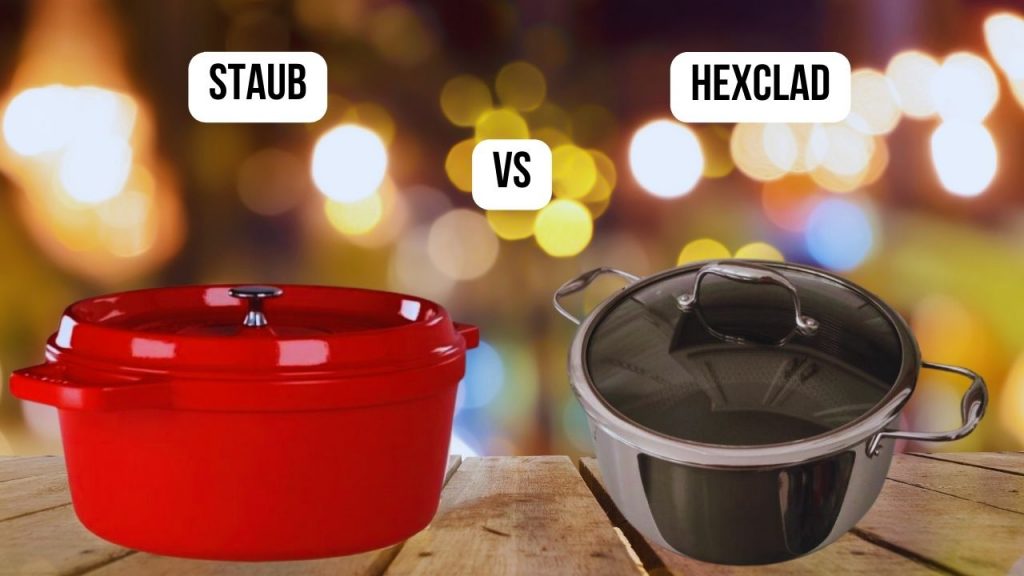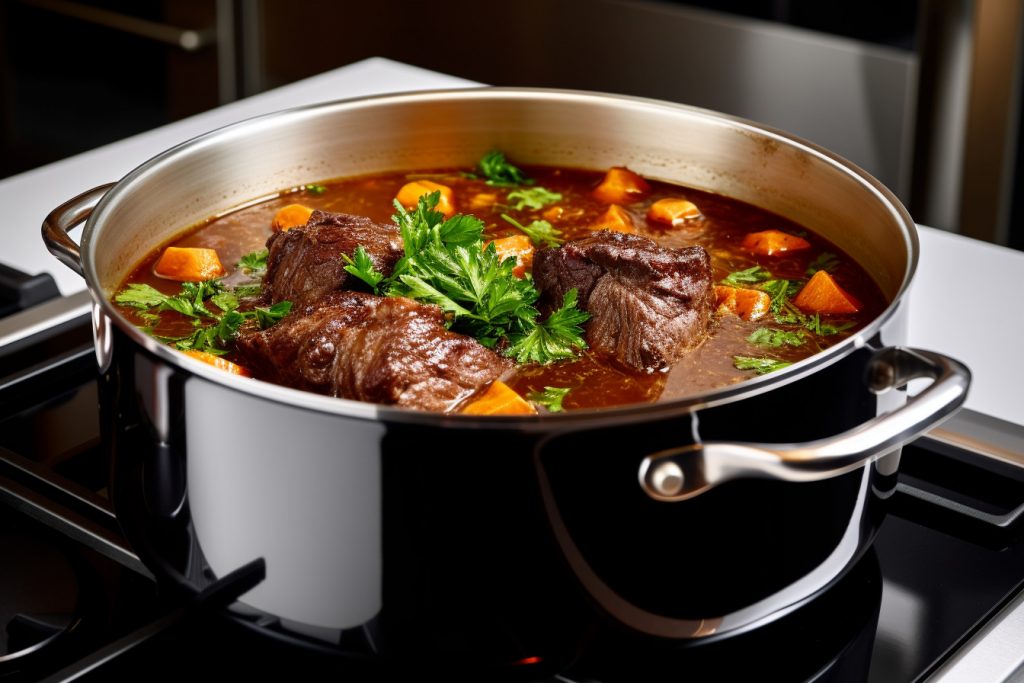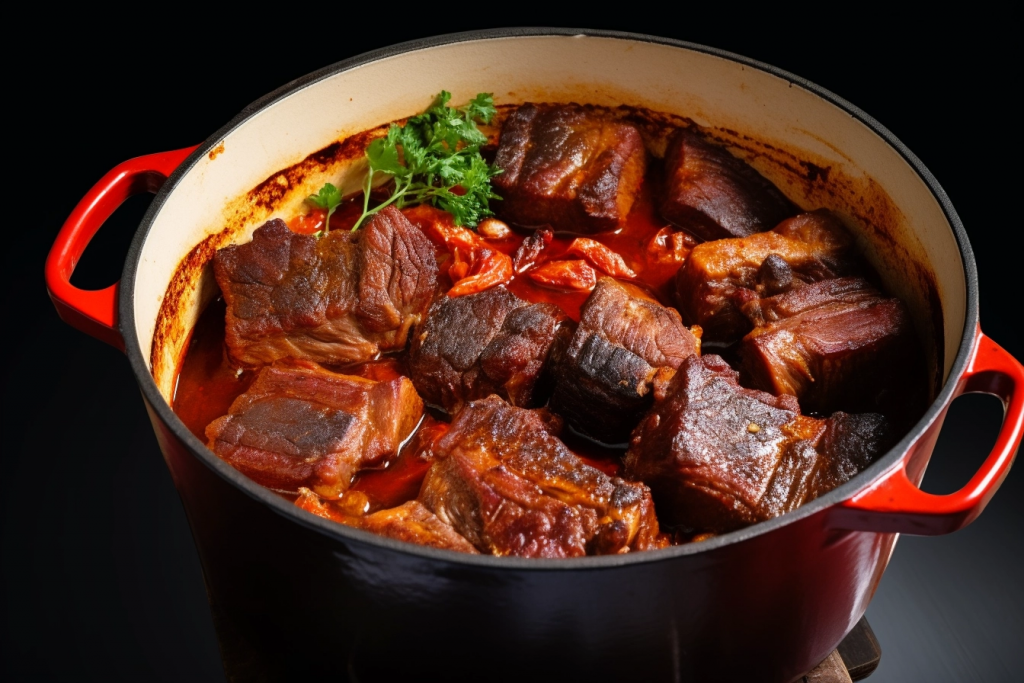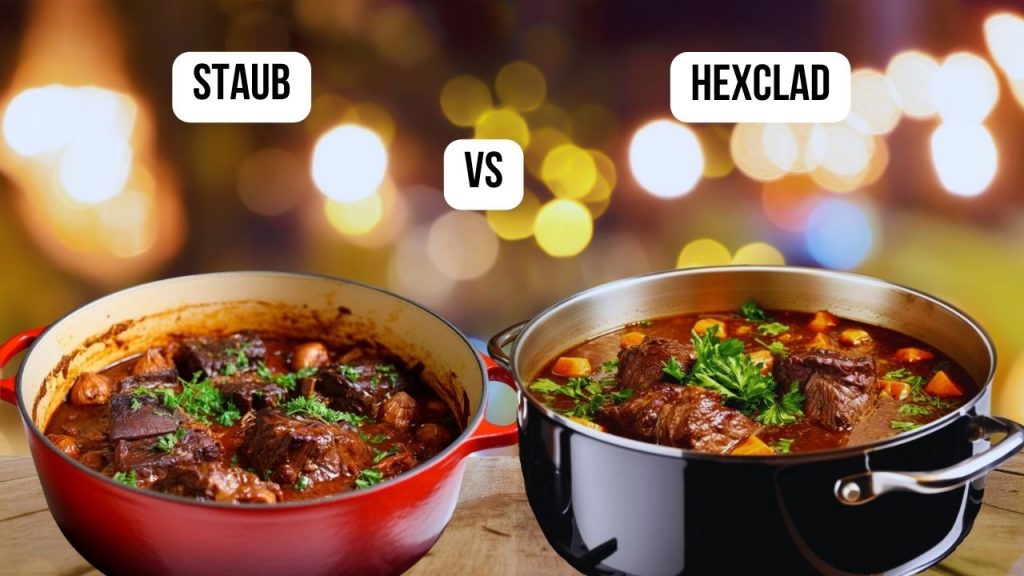
As a seasoned restaurant chef with over ten years of experience, I understand the importance of having the right tools in the kitchen. In this article, I’ll be comparing the HexClad Dutch Oven with the Staub Dutch Oven. We’ll evaluate these two based on ten key factors that are crucial when choosing a Dutch oven:
- Material
- Weight
- Heat retention and compatibility
- Lid fit
- Handles and product design
- Colors
- Maintenance and cleaning
- Durability and performance
- Warranty
- Price
The Staub Dutch Oven has earned its place in the TOP-5 best options of dutch ovens available today.
I’ll guide you through these aspects to help you make a well-informed decision. Let’s dive into the comparison and see how these Dutch ovens stack up against each other in a practical cooking test.
Staub VS Hexclad: Material
| Staub | HexClad |
|---|---|
| Staub Dutch Ovens are constructed from high-quality cast iron, which is renowned for its excellent heat retention and even heat distribution. The interior is coated with an enamel glaze that prevents rust and food from sticking. | The HexClad Dutch Oven stands out with its stainless steel make and innovative hexagonal non-stick surface. It’s safe, free from toxins and PFOA, and utilizes a combination of ceramic, diamond dust, and stainless steel for optimal performance. |
Staub VS Hexclad: Weight
| Staub | HexClad |
|---|---|
| Staub Dutch Ovens tend to be on the heavier side due to their cast iron construction. While this weight is excellent for retaining heat, it might be a concern for those who prefer lightweight cookware. | HexClad is lightweight due to its stainless steel construction. |
Staub VS Hexclad: Heat Retention and Compatibility
| Staub | HexClad |
|---|---|
| The Staub Dutch Oven excelled in heat retention. It maintains the temperature throughout the cooking process consistently. It is versatile and suitable for various cooking methods. It performed exceptionally well on both the stovetop and oven. | The HexClad Dutch oven excels in heat retention. Its tri-ply design, incorporating an aluminum layer between two stainless steel layers, ensures exceptional heat distribution, resulting in consistent cooking temperatures. This Dutch oven’s heat compatibility is also impressive. It can be used on gas, electric, and induction stovetops and in ovens up to 500 degrees Fahrenheit. |
Staub VS Hexclad: Lid Fit
| Staub | HexClad |
|---|---|
| The tight-fitting lid in Staub Dutch Ovens ensures a snug seal, trapping moisture and flavor inside the pot, making it ideal for long-simmering dishes. | The HexClad Dutch oven‘s lid provides a snug fit, effectively sealing moisture and flavors while braising. |
Staub VS Hexclad: Handles and Product Design
| Staub | HexClad |
|---|---|
| The Staub Dutch Oven features ergonomic handles, although I find the space a bit narrow. It makes it slightly challenging to lift the pot, especially when wearing oven mitts. Despite this handle design concern, the Dutch Oven’s overall product design is stylish and aesthetically pleasing. Its striking enameled exterior adds an elegant touch to the kitchen, making it a versatile piece suitable for cooking and serving. | The handles of HexClad are practical and ergonomic. I can firmly grasp the pot even when using oven mitts. This Dutch oven has a clean and classic style that will complement any kitchen. |
Staub VS Hexclad: Colors
| Staub | HexClad |
|---|---|
| Staub offers various elegant and vibrant colors to match your kitchen decor. | HexClad is exclusively offered in its signature stainless steel design with a round shape in a 5-quart size. |
Staub VS Hexclad: Maintenance and Cleaning
| Staub | HexClad |
|---|---|
| Maintaining the Staub Dutch Oven is a breeze. The enamel interior is resistant to staining and remarkably easy to clean. After hours of slow-cooking the short ribs, I only needed a brief soak and a gentle scrub to have it looking as good as new. | HexClad has a non-stick surface, making cleaning effortless with a simple wipe or gentle scrub. However, it’s essential to consider that the long-term durability of this non-stick coating may not meet some users’ expectations. |
Staub VS Hexclad: Durability and Performance
| Staub | HexClad |
|---|---|
| Staub Dutch Ovens are renowned for their durability and performance. They can last a lifetime if well-maintained and are a chef’s favorite for slow-cooked stews and braises. | The HexClad Dutch Oven offers outstanding cooking performance, delivering tender and flavorful results with various dishes, including short ribs, soups, stews, and searing meats. However, I think it may not match the longevity of cast iron Dutch ovens. |
Staub VS Hexclad: Warranty
| Staub | HexClad |
|---|---|
| Staub provides a lifetime warranty with certain limitations for their cast iron cookware. This warranty addresses functional, material, and manufacturing defects found in cast iron cookware. | HexClad provides a limited lifetime warranty similar to other leading Dutch oven brands. |
Staub VS Hexclad: Price
| Staub | HexClad |
|---|---|
| Staub Dutch Ovens are an investment with a price point that reflects their quality. They may not be the most budget-friendly option, but their longevity and performance make them worth it. | HexClad costs more than the Staub Dutch oven, mainly due to its patented technology. |
Cooking Test

I carried out a comparative cooking test using the Staub and HexClad Dutch Ovens, focusing on evaluating their performance across three essential criteria.
Browning

The Staub and HexClad Dutch Ovens both excel in browning. Thanks to their outstanding heat retention and uniform heat distribution, they provide an ideal setting for attaining a rich and savory sear on meats and various other ingredients.
Moisture Retention
The Staub Dutch Oven excels at trapping moisture, perfect for recipes such as braised short ribs or stews, delivering tender and juicy outcomes.
On the other hand, while the HexClad Dutch Oven performs well in retaining moisture, it may not reach the same efficiency as the Staub. Nonetheless, it still manages to keep an adequate amount of moisture in the cooked dishes.
Final Flavor

The Staub Dutch Oven‘s cast iron build significantly enriches the flavor of meals prepared in it. This material is particularly adept at deepening the taste profile, especially in slow-cooked recipes.
In contrast, the HexClad Dutch Oven, featuring its stainless steel and non-stick construction, may not impart as intense a flavor as cast iron. However, it effectively maintains and elevates the flavors in the dishes it cooks.
How We Tested
In order to accurately compare the Staub and HexClad Dutch Ovens, we adopted a structured testing method. This approach allowed us to meticulously assess their performance across various culinary aspects.
Our first test was on their browning efficiency. We seared different types of meat and ingredients in each Dutch oven, observing their capacity to produce a uniform and rich crust. We maintained identical cooking durations and temperatures for a balanced comparison.
We then examined moisture retention. During the cooking process, we tracked and evaluated the moisture levels in each Dutch oven, analyzing how effectively they preserved it.
Lastly, to determine their influence on the overall flavor of the dishes, we prepared the same recipes in both Dutch ovens. After cooking, we conducted taste tests to compare the flavor profiles of the dishes from each Dutch oven, noting any variances in taste intensity and quality.
Conclusion
In conclusion, after a comprehensive comparison and cooking test between the Staub and HexClad Dutch Ovens, it is clear that Staub stands out as the superior choice.
Throughout our evaluation, covering material, weight, heat retention, lid fit, handle design, color options, maintenance, durability, warranty, and price, Staub consistently demonstrated its excellence. Its high-quality cast iron construction, coupled with excellent heat retention and even distribution, makes it ideal for a wide range of cooking methods. The enamel interior further adds to its appeal, ensuring ease of maintenance and longevity.
In the practical cooking test, the Staub Dutch Oven excelled in browning, moisture retention, and imparting a rich flavor to dishes. Its ability to lock in moisture and enhance the taste of slow-cooked meals like braised short ribs and stews was particularly noteworthy. Although the HexClad Dutch Oven performed admirably, especially in terms of its innovative design and heat compatibility, it couldn’t match the depth of flavor and durability that Staub offers.
Considering all these factors, including Staub’s lifetime warranty, it becomes evident that while it may be a higher investment initially, its performance and durability offer greater long-term value. For chefs and home cooks who prioritize quality and performance in their cookware, the Staub Dutch Oven is undoubtedly the winner in this comparison.
Make sure to check our the best Dutch ovens list.
